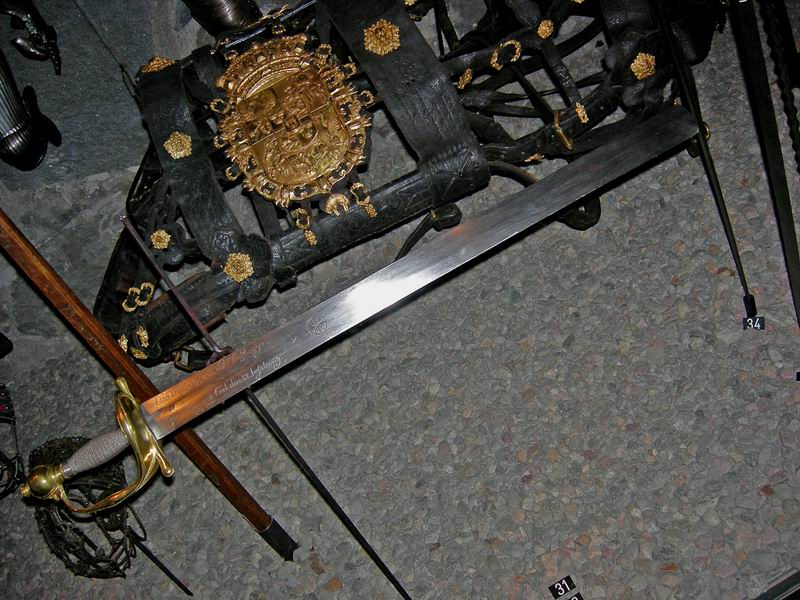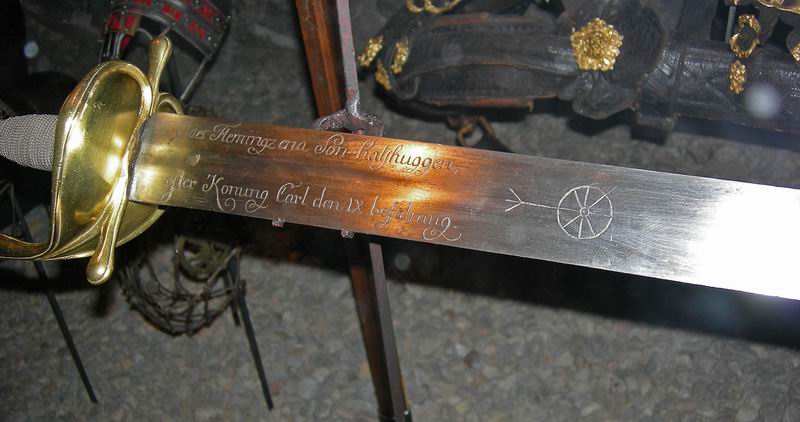| Author |
Message |
Sa'ar Nudel

|
 Posted: Wed 06 May, 2009 9:25 am Post subject: Posted: Wed 06 May, 2009 9:25 am Post subject: |
 |
|
That's e very interesting sword. Plain yet robust and purpose-looking implement. We don't have measurements, but the hilt seems larger than usual for beheading sword; those proprtions might have been suitable for a fighting two- handed sword.
I find the time is right to post phoyos of a beheading sword from the military collection in Stockholm - I thank my colleague (from another site) kisak from Sweden. I quote kisak's input:
" The odd hilt on the executioner's sword is due to it having been re-hilted after it's working life. The hilt is a Swedish cavalry officer's type, seen from the end of the 17th century to the early 19th. I would guess early 18th century for this one.
As for the blade, the museum attributes it to Germany, late 16th century. The inscription reads "Claes Flemingz ena son halshuggen efter Konung Carl den IX befalning", translating roughly to "One of the sons of Clas Fleming decapitated on order of King Carl IX". The son in question would be Johan Fleming, executed in Turku (Finland was the eastern part of Sweden until 1809) in 1598."
 Attachment: 113.21 KB Attachment: 113.21 KB

 Attachment: 74.54 KB Attachment: 74.54 KB

 Attachment: 55.31 KB Attachment: 55.31 KB

Curator of Beit Ussishkin, regional nature & history museum, Upper Galilee.
|
|
   |
 |
|
Peter Johnsson
Industry Professional
|
 Posted: Wed 06 May, 2009 12:36 pm Post subject: Posted: Wed 06 May, 2009 12:36 pm Post subject: |
 |
|
| Oleg Naumov wrote: | Hi Gents,
This sword is in exhibition of Central Naval Museum, Saint Petersburg. According to explanatory text that sword was captured by Russian troops at Swedish military ship “Astrild” during the battle at river Neva on May 7, 1703. There are three hallmarks and inscription on the blade probably in Swedish. It translated as “I was made in Wira”. That sword was probably produced in 1657.
It would be great to read some comments on that sword especially from Swedes.
Sincerely,
Oleg |
This type of sword is an example of the weapon of rank of the commander of ships in the Swedish navy at this time period. They were not executioners swords, but badges of rank. The ones I have seen in the Royal Armouries in Stockholm are sharp and seemed to me somethingelse than just ceremonial objects. In sources from the period they are named "Slag Swärd" (= Battle Sword) or "Befähl Swärd" (=Commander Sword).
I size and proportion they are larger and slimmer than heading swords. The grips are longer and the guards are wider.
I have seen one text from the period, an eye witness description, how the commander of a ship wielded his "Slag Swärd" with two hands in a desperate fight aboard his ship (sorry, do not remember where I saw this text!).
The example you posted have the blunted point of an executioner sword, but many examples have a more traditional spade shaped or pointed end of a weapon of war. The square-cut end that some examples have might show that the Commander of the ship had right and duty to sit judge and deal life or death to his subordinates.
|
|
   |
 |
|
Oleg Naumov
Location: Saint Petersburg Joined: 02 Feb 2009
Posts: 20
|
 Posted: Thu 07 May, 2009 4:25 am Post subject: Posted: Thu 07 May, 2009 4:25 am Post subject: |
 |
|
Gentlemen,
Thank you for you cooperation and information you provided here.
Sincerely,
Oleg
|
|
   |
 |
Artis Aboltins

|
 Posted: Thu 07 May, 2009 6:07 am Post subject: Posted: Thu 07 May, 2009 6:07 am Post subject: |
 |
|
| Peter Johnsson wrote: | | Oleg Naumov wrote: | Hi Gents,
This sword is in exhibition of Central Naval Museum, Saint Petersburg. According to explanatory text that sword was captured by Russian troops at Swedish military ship “Astrild” during the battle at river Neva on May 7, 1703. There are three hallmarks and inscription on the blade probably in Swedish. It translated as “I was made in Wira”. That sword was probably produced in 1657.
It would be great to read some comments on that sword especially from Swedes.
Sincerely,
Oleg |
This type of sword is an example of the weapon of rank of the commander of ships in the Swedish navy at this time period. They were not executioners swords, but badges of rank. The ones I have seen in the Royal Armouries in Stockholm are sharp and seemed to me something else than just ceremonial objects. In sources from the period they are named "Slag Swärd" (= Battle Sword) or "Befähl Swärd" (=Commander Sword).
I size and proportion they are larger and slimmer than heading swords. The grips are longer and the guards are wider.
I have seen one text from the period, an eye witness description, how the commander of a ship wielded his "Slag Swärd" with two hands in a desperate fight aboard his ship (sorry, do not remember where I saw this text!).
The example you posted have the blunted point of an executioner sword, but many examples have a more traditional spade shaped or pointed end of a weapon of war. The square-cut end that some examples have might show that the Commander of the ship had right and duty to sit judge and deal life or death to his subordinates. |
If my memory serves, there is another such sword on display in the "Vaasamuseet" in Stockholm - also marked as "officers sword" I belive. So it might well be that we are looking at several different groups of weapons here - one group specifically intended and made to be executioner's weapon, another - used as such even though originally made as normal combat weapons and yet another that was intended primarily for combat and ceremonial weapons for Naval officers but could have also has symbolic ties to executioner's tools.
|
|
  |
 |
|
Bryan Johnson
|
 Posted: Mon 11 May, 2009 11:36 am Post subject: Posted: Mon 11 May, 2009 11:36 am Post subject: |
 |
|
Jonathan
There area number of headsman swords on display in the Criminal Museum in the walled city of Rothenburg ob der Tauber. I'll send you some pics of the swords there to your email. I have abook from the museum as wel if you are interrested.
Bryan
Bryan Johnson
|
|
  |
 |
|
|
You cannot post new topics in this forum
You cannot reply to topics in this forum
You cannot edit your posts in this forum
You cannot delete your posts in this forum
You cannot vote in polls in this forum
You cannot attach files in this forum
You can download files in this forum
|
All contents © Copyright 2003-2024 myArmoury.com — All rights reserved
Discussion forums powered by phpBB © The phpBB Group
Switch to the Basic Low-bandwidth Version of the forum
|

